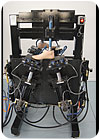
The Orion system is currently used to test prosthetics, but it could be modified for test applications in a number of industries. Source: Delta Computer Systems Inc.
Many nondestructive testing applications involve repetitive exercising of a device under test (DUT) by an automated motion system. If all that is required is causing a motion sequence and counting the cycles, and possibly some simple data logging, then use of an intelligent motion controller is unnecessary. However, test systems that use programmable electronic motion controllers can provide benefits that outweigh the extra cost of the control system.
The use of programmable motion control yields distinct advantages in tests involving the emulation of complex real-world conditions that require the control of the amount of force being applied to the DUT in addition to displacement. For example, in the medical industry, consider the system required to test an artificial foot. The International Organization for Standardization (ISO) specifies a standard procedure for static and cyclic strength testing of lower-limb prostheses using compound loadings of a predetermined amount of force. Such a system could be built without a programmable motion controller, but using one allows operators to apply complex test protocols with more precision and makes it easier to vary test parameters and log test data.
A case in point is the ISO 10328 test system developed by Orion Test Systems & Engineering Inc. (Lake Orion, MI). The system applies a precision load to the artificial foot in a cyclical manner. Options include exercising just the toe or heel, or a synchronized combination of heel and toe motion, with varying amounts of force generated by programmed waveform motion patterns such as a sine wave, a sawtooth profile or a series of square wave-shaped step pulses. Using the system, a prosthetics manufacturer can create a script that defines a complete test sequence. The script defines whether the test will use force or position control, minimum and maximum force or position to be used, and the number of cycles to be run. The script can be set up to alternate between cycle patterns. After a script is created, the PC generates the appropriate commands for the motion controller, causing it to execute the correct motion. The PC then obtains data from the motion controller for use in plotting and archiving test information.

Delta’s motion controllers can implement continuous motion according to waveform motion patterns such as a sine wave, a sawtooth profile or a series of square wave-shaped step pulses. Source: Delta Computer Systems Inc.
Delta motion controllers were chosen because of their built-in support for controlling both force and position, with the ability to switch smoothly from controlling position to controlling force in fluid power (both hydraulic and pneumatic) applications. Secondly, the motion controllers’ supporting software enables graphing of motion profiles. Orion’s software engineer was able to incorporate Delta’s graphs into the test system’s graphical user interface (GUI). As the PC is monitoring the test system’s motion, it stores the motion data in a file for later reference. The test data file serves as documentation that the system meets ISO requirements.
The system has independently controlled axes making it flexible enough to test pylons (artificial legs) in addition to feet. With simple mechanical changes, the system could be used to test other prosthetic body parts such as artificial hips, or products in other industries such as automotive brake pedals and shock absorbers. The system also could be modified for military or aerospace test applications.
Tuning of the Orion system required a modification to Delta’s motion controllers to facilitate controlling two axes that work against each other out of phase. During the process of working with Orion engineers to implement the enhancements, Delta support engineers were able to access Orion’s system remotely via the Internet, saving time and money while making the system tuning process easier.
“The system has been running for months and has done millions of test cycles at our customer’s site,” says Rob Pilat, president, Orion Test Systems & Engineering Inc.
- Delta Computer Systems Inc.
(360) 254-8688
www.deltamotion.com
Reply 52